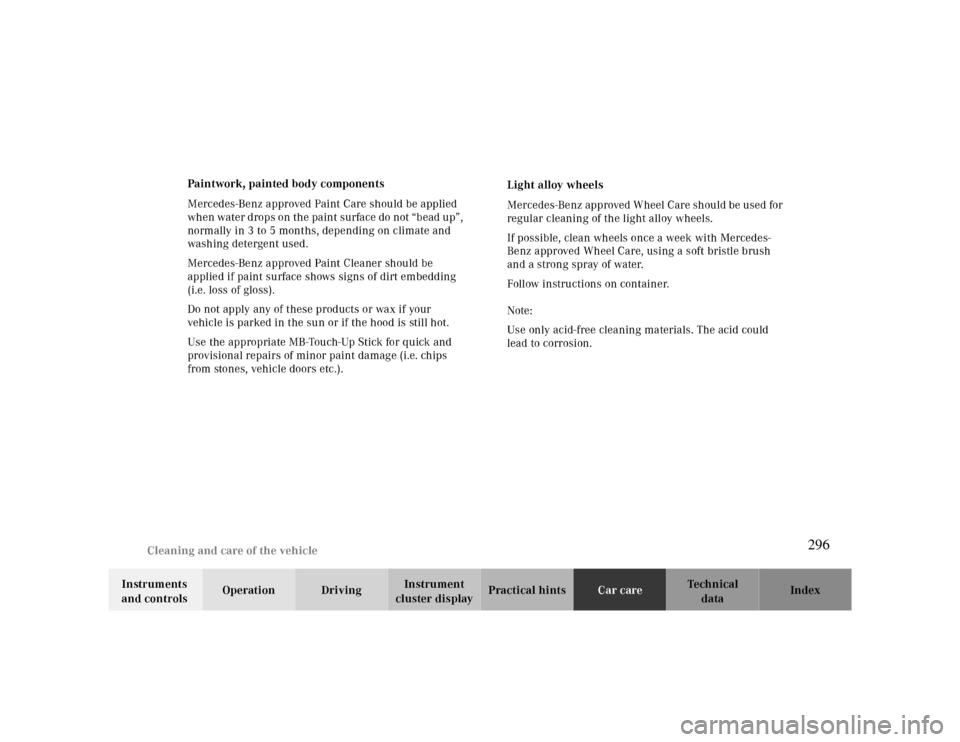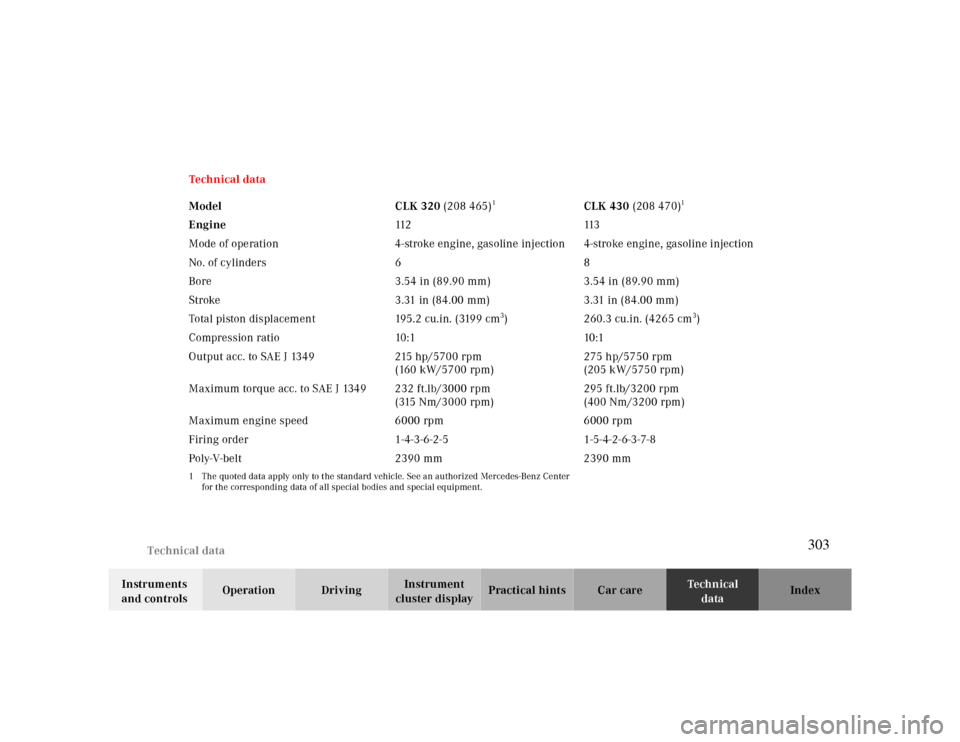Page 294 of 323

Cleaning and care of the vehicle
Te ch n ica l
data Instruments
and controlsOperation DrivingInstrument
cluster displayPractical hintsCar careIndex
Tar stains
Quickly remove tar stains before they dry and become
more difficult to remove. A tar remover is
recommended.
Headlamps, taillamps, turn signal lenses
Use a mild car wash detergent, such as Mercedes-Benz
approved Car Shampoo, with plenty of water.
To prevent scratches, never apply strong force and use
only a soft, non-scratchy cloth when cleaning the lenses.
Do not attempt to wipe dirty lenses with a dry cloth or
sponge. Window cleaning
Use a window cleaning solution on all glass surfaces. An
automotive glass cleaner is recommended.
Wiper blade
Clean the wiper blade rubber with a clean cloth and
detergent solution. Instrument cluster
Use a gentle dishwashing detergent or mild detergent
for delicate fabrics as a washing solution. Wipe with a
cloth moistened in lukewarm solution. Do not use
scouring agents. Seat belts
The webbing must not be treated with chemical
cleaning agents. Use only clear, lukewarm water and
soap. Do not dry the webbing at temperatures above
176°F (80°C) or in direct sunlight.
Headliner
Clean with soft bristle brush, or use a dry-shampoo
cleaner in case of excessive dirt.
Wa r n i n g !
Do not bleach or dye seat belts as this may severely
weaken them. In a crash they may not be able to
provide adequate protection.
294
Page 295 of 323

Cleaning and care of the vehicle
Te ch n ica l
data Instruments
and controlsOperation DrivingInstrument
cluster displayPractical hintsCar careIndex
OrnamentalMoldings
For regular cleaning and care of very dirty chrome-
plated parts, use a chrome cleaner. Upholstery
Using aftermarket seat covers or wearing clothing that
have the tendency to give off coloring (e.g. when wet
etc.) may cause the upholstery to become permanently
discolored. By lining the seats with a proper
intermediate cover, contact-discoloration will be
prevented.Leather Upholstery
Wipe leather upholstery with a damp cloth and dry
thoroughly or clean with Mercedes-Benz approved
Leather Care. Exercise particular care when cleaning
perforated leather as its underside should not become
wet.
MB Tex Upholstery
Pour Mercedes-Benz approved Interior Care onto soft
lint-free cloth and apply with light pressure. Hard plastic trim items
Pour Mercedes-Benz approved Interior Care onto soft
lint-free cloth and apply with light pressure.Steering wheel and gear selector lever
Wipe with a damp cloth and dry thoroughly or clean
with Mercedes-Benz approved Leather Care.
295
Page 296 of 323

Cleaning and care of the vehicle
Te ch n ica l
data Instruments
and controlsOperation DrivingInstrument
cluster displayPractical hintsCar careIndex
Paintwork, painted body components
Mercedes-Benz approved Paint Care should be applied
when water drops on the paint surface do not “bead up”,
normally in 3 to 5 months, depending on climate and
washing detergent used.
Mercedes-Benz approved Paint Cleaner should be
applied if paint surface shows signs of dirt embedding
(i.e. loss of gloss).
Do not apply any of these products or wax if your
vehicle is parked in the sun or if the hood is still hot.
Use the appropriate MB-Touch-Up Stick for quick and
provisional repairs of minor paint damage (i.e. chips
from stones, vehicle doors etc.).Light alloy wheels
Mercedes-Benz approved Wheel Care should be used for
regular cleaning of the light alloy wheels.
If possible, clean wheels once a week with Mercedes-
Benz approved Wheel Care, using a soft bristle brush
and a strong spray of water.
Follow instructions on container.
Note:
Use only acid-free cleaning materials. The acid could
lead to corrosion.
296
Page 297 of 323

Cleaning and care of the vehicle
Te ch n ica l
data Instruments
and controlsOperation DrivingInstrument
cluster displayPractical hintsCar careIndex
Soft top
Clean soft top with soft top raised and locked. Lower the
soft top into the storage compartment only if the soft top
is completely dry. If the soft top is kept in the storage
compartment for a lengthy period, raise it and air out
with the windows open about every 4 months.
Dry cleaning:
Brush top (always from front to rear) with a soft-bristled
brush.
Wet cleaning:
Brush the dry top. Wash with a mild detergent and an
ample supply of lukewarm water by wiping with a soft-
bristled brush or sponge from front to rear. Then rinse
thoroughly with clear water.
If only parts of the top have been washed, wet the entire
top and allow it to air-dry before lowering it into the
storage compartment.
Do not use sharp-edged instruments for the removal of
ice and snow. Notes:
When you run the vehicle through an automatic car
wash, never use hot-wax for conservation.
Depending on the operation mode of the car wash, there
is the possibility of water drops entering the vehicle’s
interior.
Never use a power washer to clean the soft top, as you
may damage the soft top material.
Remove bird droppings immediately. The organic acid
damages the material and causes the soft top to leak.
In general, regular spraying or cleansing with clear
water is sufficient to keep the top clean.
Wash the top only when heavily soiled.
Light colored soft tops should be cleaned frequently to
prevent spots and dirt from setting in, which could stain
and discolor the soft top material permanently.
Caution!
Never use any gasoline, thinner, tar and stain removers,
glass cleaner, or similar organic solvents to clean the
soft top or wind screen. They will cause damage which
is not covered by the Mercedes-Benz Limited Warranty.
297
Page 298 of 323
Cleaning and care of the vehicle
Te ch n ica l
data Instruments
and controlsOperation DrivingInstrument
cluster displayPractical hintsCar careIndex Wind screen
Use only water or mild detergent to clean the wind
screen. Rubber weatherstrip
The door and windshield header rubber weatherstrip
material should be cared for at regular intervals with a
silicon-based car care product.
298
Page 300 of 323

Technical data
Te ch n ica l
data Instruments
and controlsOperation DrivingInstrument
cluster displayPractical hints Car care Index
Spare parts service
All authorized Mercedes-Benz Centers maintain a stock
of original spare parts required for maintenance and
repair work. In addition, strategically located parts
distribution centers provide quick and reliable parts
service.
More than 300 000 different spare parts, for
Mercedes-Benz models, are available.
Mercedes-Benz original spare parts are subjected to
stringent quality inspections. Each part has been
specifically developed, manufactured or selected for and
adapted to Mercedes-Benz vehicles.
Therefore, Mercedes-Benz original spare parts should
be installed.
Important!
The use of non-genuine parts and accessories not
authorized by Mercedes-Benz could damage the vehicle
which damage is not covered by the Mercedes-Benz
Limited Warranty or compromise its durability or safety.Warranty coverage
Your vehicle is covered under the terms of the
“warranties” printed in the Service and Warranty
Information booklet and your authorized
Mercedes-Benz Center will exchange or repair any
defective parts originally installed on the vehicle in
accordance with the terms of the following warranties:
1. New vehicle limited warranty
2. Emission system warranty
3. Emission performance warranty
4. California, Massachusetts, and Vermont emission
control systems warranty
Replacement parts and accessories are covered by the
Mercedes-Benz Spare Parts and Accessories warranties,
copies of which are available at any Mercedes-Benz
Center.
Loss of Service and Warranty Information Booklet
Should you lose your Service and Warranty Information
booklet, have your authorized Mercedes-Benz Center
arrange for a replacement. It will be mailed to you.
300
Page 301 of 323
Technical data
Te ch n ica l
data Instruments
and controlsOperation DrivingInstrument
cluster displayPractical hints Car care Index Identification labels
1Certification label2Vehicle Identification Number (VIN)
When ordering spare parts, please specify vehicle
identification and engine numbers.
1
X
X
X
X
X
X
X
X
X2
301
Page 303 of 323

Technical data
Te ch n ica l
data Instruments
and controlsOperation DrivingInstrument
cluster displayPractical hints Car care Index Te ch n ica l d a t a
Model CLK 320 (208 465)
1
CLK 430 (208 470)
1
Engine11 2 113
Mode of operation 4-stroke engine, gasoline injection 4-stroke engine, gasoline injection
No. of cylinders 6 8
Bore 3.54 in (89.90 mm) 3.54 in (89.90 mm)
Stroke 3.31 in (84.00 mm) 3.31 in (84.00 mm)
Total piston displacement 195.2 cu.in. (3199 cm
3) 260.3 cu.in. (4265 cm
3)
Compression ratio 10:1 10:1
Output acc. to SAE J 1349 215 hp/5700 rpm
(160 kW/5700 rpm)275 hp/5750 rpm
(205 kW/5750 rpm)
Maximum torque acc. to SAE J 1349 232 ft.lb/3000 rpm
(315 Nm/3000 rpm)295 ft.lb/3200 rpm
(400 Nm/3200 rpm)
Maximum engine speed 6000 rpm 6000 rpm
Firing order 1-4-3-6-2-5 1-5-4-2-6-3-7-8
Poly-V-belt 2390 mm 2390 mm
1 The quoted data apply only to the standard vehicle. See an authorized Mercedes-Benz Center
for the corresponding data of all special bodies and special equipment.
303